by Jason Bodner
April 16, 2024
Last week, I tackled the global flood that set Noah and his animals adrift, but it turns out that 70 other cultures chronicled the same story, so maybe the myth is really just a fuzzy memory.
This week, I offer the Peri Reis Map, compiled in 1513 from earlier “source maps.” Note that the coastline and mountains of Antarctica are clearly charted here. However, there is one big problem…

Antarctica wasn’t discovered until 1820. And other than Peri Reis, earlier maps never showed Antarctica:

The Peri Ries Map also shows Antarctica connected to Brazil. Obviously today an ocean separates them.
Let’s turn to the CIA for “the truth.” A once-classified book “The Adam and Eve Story,” written by a retired CIA agent, Chan Thomas, in 1966, supposedly details how a global cataclysmic flood is coming.
Magnetic fields hold the answer. The earth’s poles flip. It can be spontaneous, and poles are shifting even today. In the map below, you can see the poles shifted steadily towards Greenland over the last 100 years:

This is more than a shift. I’m talking about a flip. The Earth’s magnetic field occasionally reverses poles. It happens ranging from every 10,000 years up to every 50+ million years. The last reversal was about 780,000 years ago. Reversals are random and unpredictable and can take hundreds to thousands of years.
Recent research shows that at least one reversal could have taken place in a single year. Researchers believe the poles flipped 183 times in the last 83 million years, and several hundred times in the past 160 million years, and if the poles suddenly flipped in just one year, could it have caused a global flood?
Who knows? But again – it’s fun to indulge in such “what if” theories.
And that’s the type of stuff that drives news cycles – and volatility in the markets. Volatility is creeping up. On Friday April 12th, the VIX hit 19.20 – a level not seen since October of 2023. It closed at 17.51:
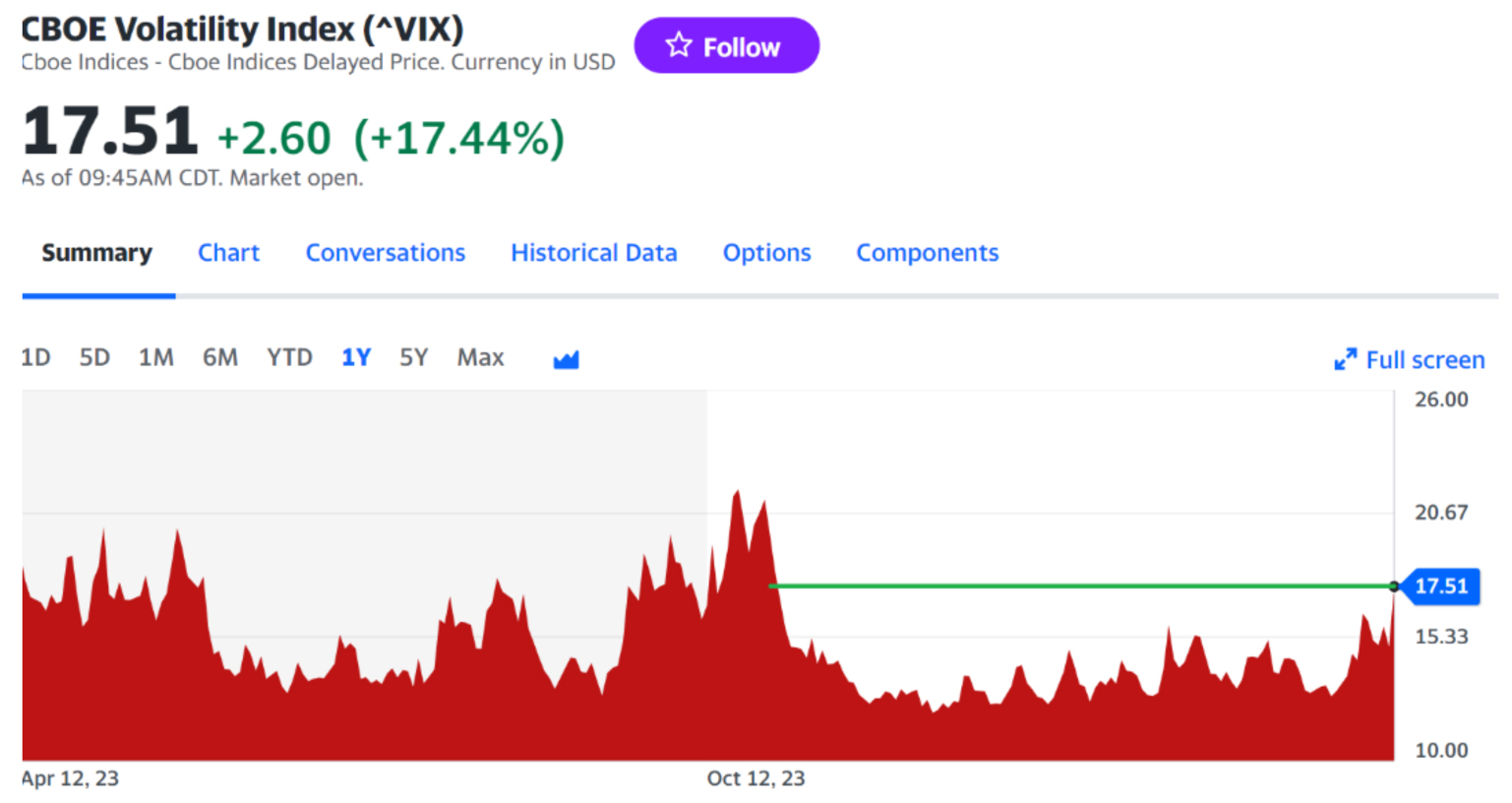
Graphs are for illustrative and discussion purposes only. Please read important disclosures at the end of this commentary.
Is a market cataclysm near, and why is this volatility happening now?
Last week saw amped-up uncertainty because bad news struck on Wednesday. The CPI report came out hotter than expected for the third month in a row. The annual rate came out as 3.5%, up from 3.2%. Gas and shelter prices impacted the index the most. The expectation of a June rate cut is now harder to justify.
Look, we know inflation will moderate and cuts are coming…. when is another matter. More importantly, earnings season is here again. Is Apocalypse coming? Not likely. Here are some statistics indicating “no.”
- According to Fact-Set, for S&P 500 companies reporting earnings, the 10-year average has 74% of companies beating earnings estimates, and 64% beating revenue estimates. That means:
- Either analysts are just plain bad at their job of getting earnings right about 75% of the time, or they want to underestimate. Either way, I say: “Let the trend continue.”
- Upcoming earnings for Q1 will likely fit the same pattern. My guess, based on recent history, is that 79% of companies will beat earnings estimates and 67% will beat sales estimates.

Graphs are for illustrative and discussion purposes only. Please read important disclosures at the end of this commentary.
If my prediction comes true – or even close – it means the economy is working well: Companies are making their sales and profit targets and are reporting rising earnings. Isn’t that what’s most important?
Sure, inflation is higher than we want, but it is still way down from its peak of 9.2%. And it is also below the 64-year average CPI of 3.77%.
Also, the effective Fed funds rate of 5.33% is more than 10% above the 64-year average of 4.8%. This delivers a positive “real” return of nearly 2%, between rates (5.33%) and inflation (3.40%), or +1.93%.
In other words, rates are 56% higher than inflation. For the last 64 years, the average spread is 1.03%, so we are nearly double that. For context, the average spread since 2000 is -0.75%. Since 2001, this phenomenon of higher rates than inflation rarely lasts long, as you can see in the chart below.
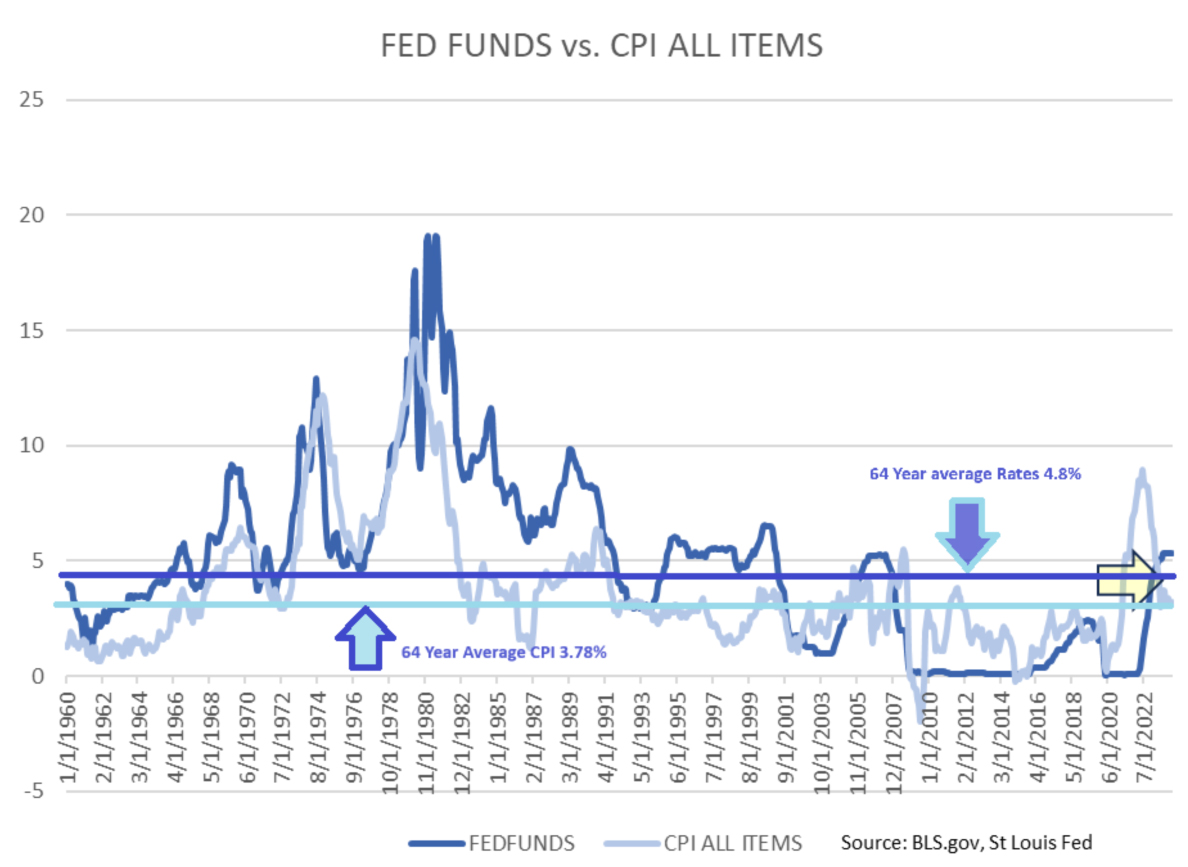
Graphs are for illustrative and discussion purposes only. Please read important disclosures at the end of this commentary.
Last week, the CPI spooked markets, putting pressure on the Big Money Index (BMI), driving it below 70 for the first time since December 4th, 2023.
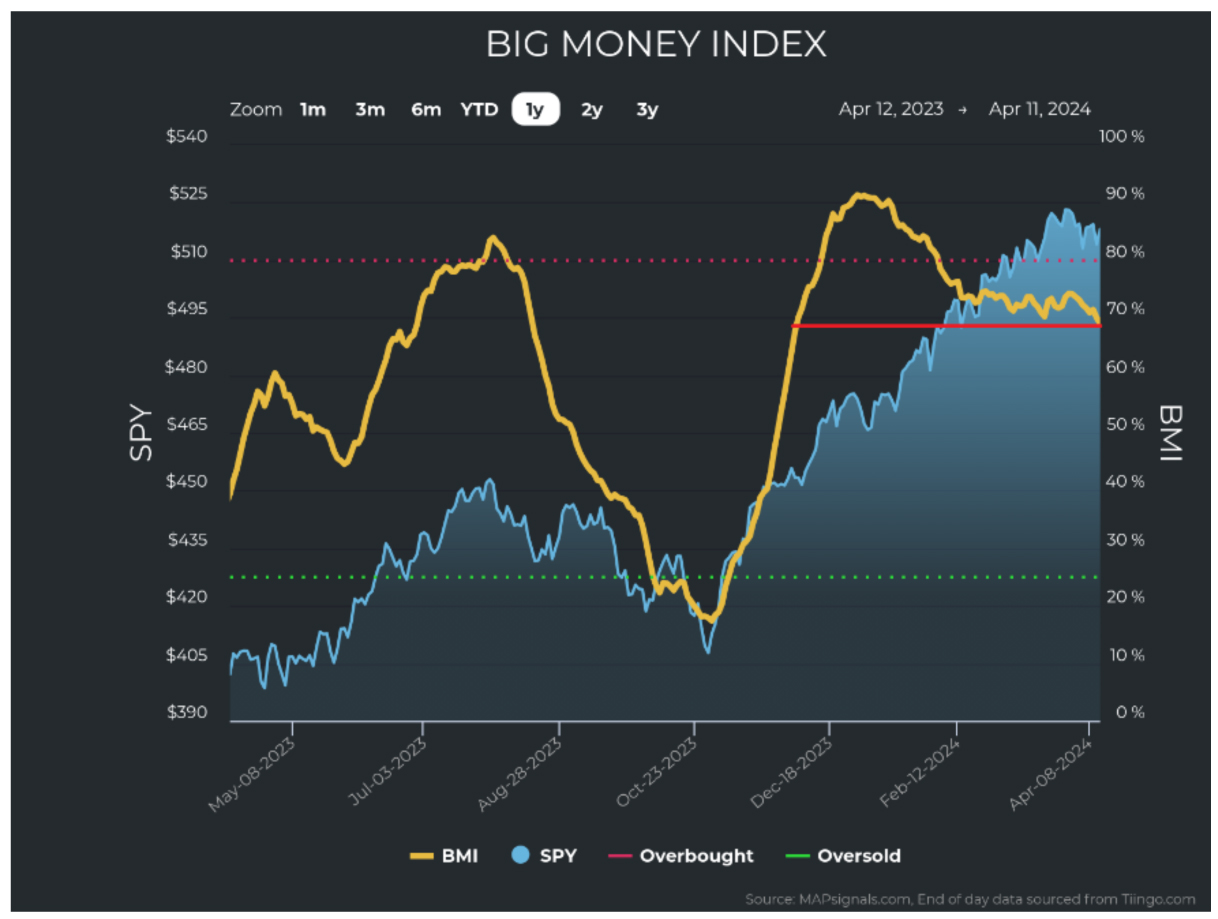
Graphs are for illustrative and discussion purposes only. Please read important disclosures at the end of this commentary.
Even with that, stock selling did not accelerate significantly, as we can see on the left, below:
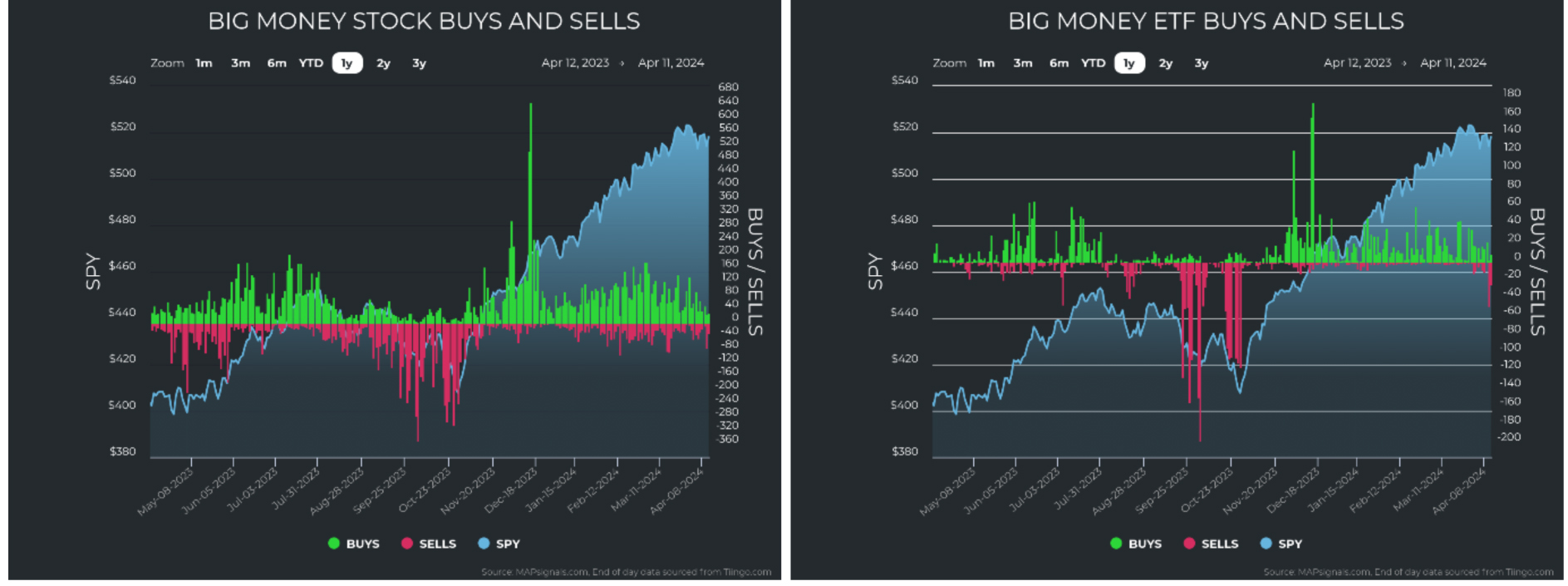
Graphs are for illustrative and discussion purposes only. Please read important disclosures at the end of this commentary.
But on the right, ETF selling did spike, specifically after the CPI report. In fact, on Wednesday, 49 ETFs saw unusually large selling. Interestingly, nearly all of them were bond, Treasury or income-related ETFs.
Looking at stock sectors, we see no real selling to get worried about…yet. Energy and Materials continue to see inflows. All other sectors remain technically strong on a chart, but buying has dwindled visibly.
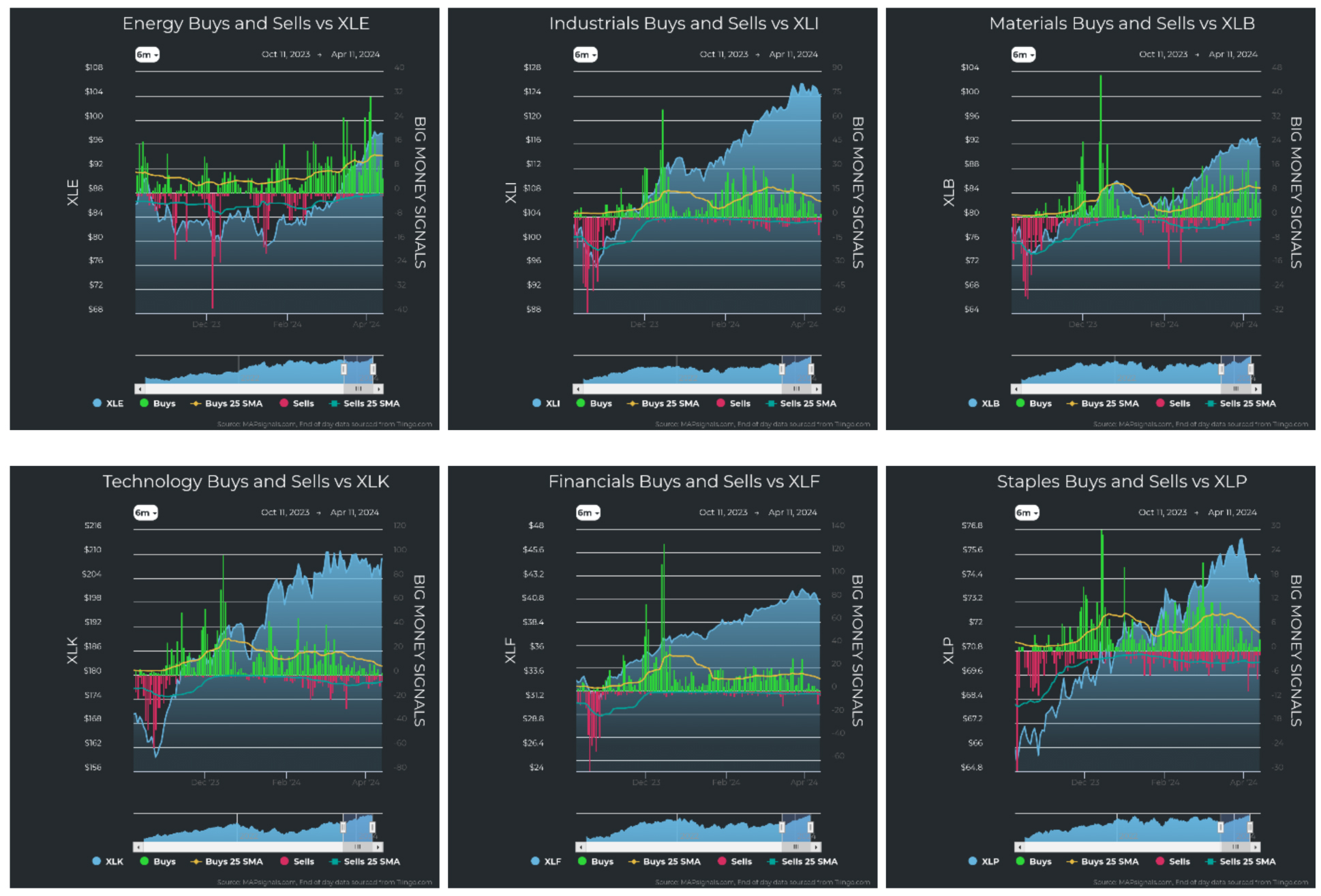
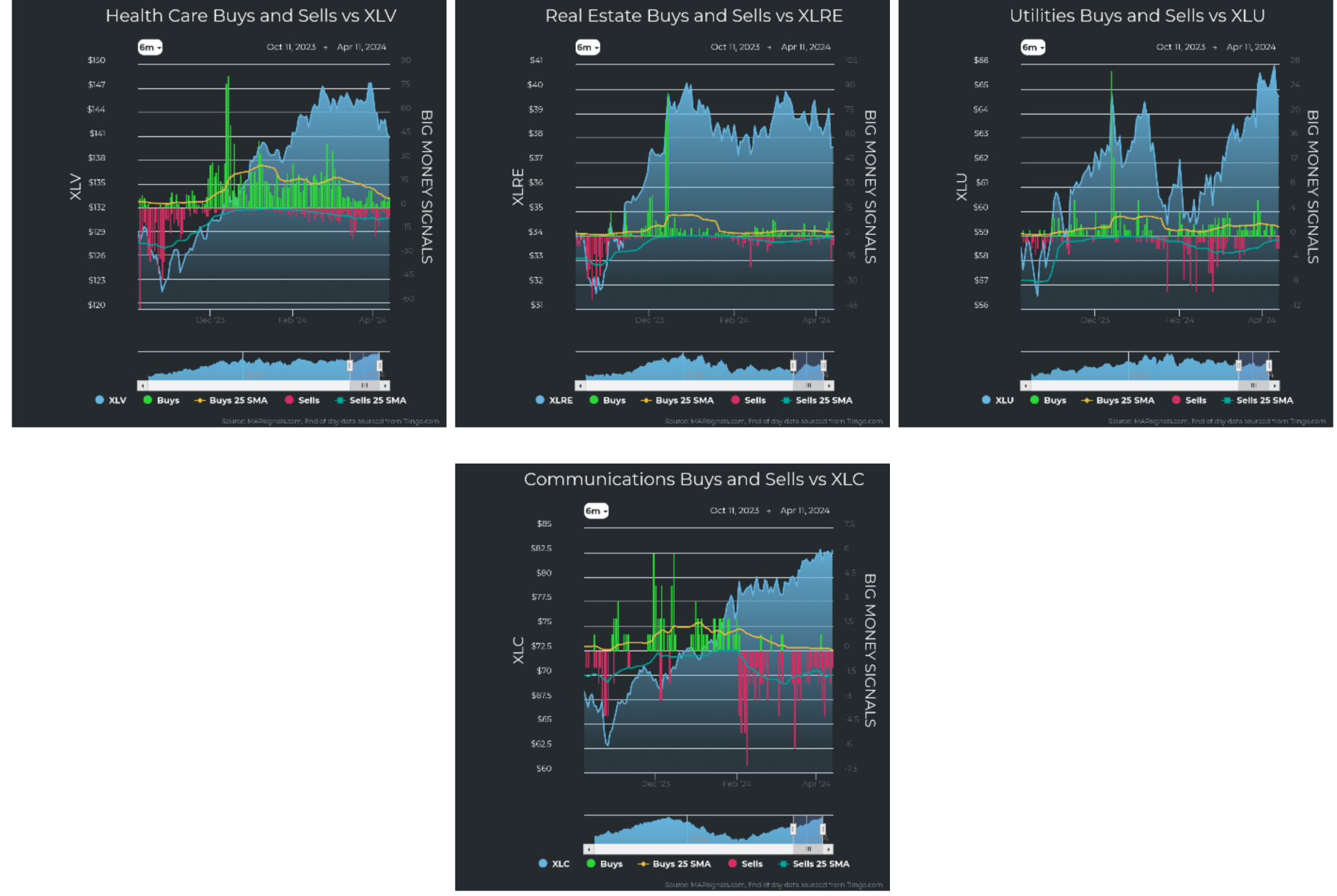
Graphs are for illustrative and discussion purposes only. Please read important disclosures at the end of this commentary.
Financials just kicked off earnings season, last Friday. Blackrock, one of the biggest, started off things positively, reporting EPS of $9.81 vs. expectations of $9.34, and revenue of $4.73 billion (vs. $4.64b).
While that certainly started the season right, the CPI kicking the Fed’s rate cuts down the road is causing concerns that the banks will face hurdles with higher rates for a longer time. We saw this as JP Morgan, Wells Fargo, and Citigroup all saw net interest income drop during the fourth quarter.
This is suddenly sparking recession chatter again. Wall Street always needs something to worry about. But while the markets were spooked somewhat last week, the internals still look good. I still anticipate strong sales and earnings growth with the rosy backdrop of rate cuts on the horizon… eventually.
As more earnings come online, let’s see where they fall in terms of history.
The earth’s poles may flip and take us all out. Or maybe not. I’ll assume the latter! Charles Schultz said it best: “Don’t worry about the world coming to an end today. It is already tomorrow in Australia.”
Navellier & Associates does not hold Citigroup (C), Wells Fargo & Co (WFC), JPMorgan Chase & CO (JPM), or Blackrock in Managed accounts. Jason Bodner does not own Citigroup (C), Wells Fargo & Co (WFC), JPMorgan Chase & CO (JPM), or Blackrock personally.
All content above represents the opinion of Jason Bodner of Navellier & Associates, Inc.
Also In This Issue
A Look Ahead by Louis Navellier
The Global Implications of Rising Energy Prices
Income Mail by Bryan Perry
Factoring In the New War Realities
Growth Mail by Gary Alexander
How to Create a Roaring (2nd Half of the) Twenties
Global Mail by Ivan Martchev
Possible Rising Recriminations Face the Stock Market
Sector Spotlight by Jason Bodner
Is a Market Cataclysm Coming Soon?
View Full Archive
Read Past Issues Here

Jason Bodner
MARKETMAIL EDITOR FOR SECTOR SPOTLIGHT
Jason Bodner writes Sector Spotlight in the weekly Marketmail publication and has authored several white papers for the company. He is also Co-Founder of Macro Analytics for Professionals which produces proprietary equity accumulation/distribution research for its clients. Previously, Mr. Bodner served as Director of European Equity Derivatives for Cantor Fitzgerald Europe in London, then moved to the role of Head of Equity Derivatives North America for the same company in New York. He also served as S.V.P. Equity Derivatives for Jefferies, LLC. He received a B.S. in business administration in 1996, with honors, from Skidmore College as a member of the Periclean Honors Society. All content of “Sector Spotlight” represents the opinion of Jason Bodner
Important Disclosures:
Jason Bodner is a co-founder and co-owner of Mapsignals. Mr. Bodner is an independent contractor who is occasionally hired by Navellier & Associates to write an article and or provide opinions for possible use in articles that appear in Navellier & Associates weekly Market Mail. Mr. Bodner is not employed or affiliated with Louis Navellier, Navellier & Associates, Inc., or any other Navellier owned entity. The opinions and statements made here are those of Mr. Bodner and not necessarily those of any other persons or entities. This is not an endorsement, or solicitation or testimonial or investment advice regarding the BMI Index or any statements or recommendations or analysis in the article or the BMI Index or Mapsignals or its products or strategies.
Although information in these reports has been obtained from and is based upon sources that Navellier believes to be reliable, Navellier does not guarantee its accuracy and it may be incomplete or condensed. All opinions and estimates constitute Navellier’s judgment as of the date the report was created and are subject to change without notice. These reports are for informational purposes only and are not a solicitation for the purchase or sale of a security. Any decision to purchase securities mentioned in these reports must take into account existing public information on such securities or any registered prospectus.To the extent permitted by law, neither Navellier & Associates, Inc., nor any of its affiliates, agents, or service providers assumes any liability or responsibility nor owes any duty of care for any consequences of any person acting or refraining to act in reliance on the information contained in this communication or for any decision based on it.
Past performance is no indication of future results. Investment in securities involves significant risk and has the potential for partial or complete loss of funds invested. It should not be assumed that any securities recommendations made by Navellier. in the future will be profitable or equal the performance of securities made in this report. Dividend payments are not guaranteed. The amount of a dividend payment, if any, can vary over time and issuers may reduce dividends paid on securities in the event of a recession or adverse event affecting a specific industry or issuer.
None of the stock information, data, and company information presented herein constitutes a recommendation by Navellier or a solicitation to buy or sell any securities. Any specific securities identified and described do not represent all of the securities purchased, sold, or recommended for advisory clients. The holdings identified do not represent all of the securities purchased, sold, or recommended for advisory clients and the reader should not assume that investments in the securities identified and discussed were or will be profitable.
Information presented is general information that does not take into account your individual circumstances, financial situation, or needs, nor does it present a personalized recommendation to you. Individual stocks presented may not be suitable for every investor. Investment in securities involves significant risk and has the potential for partial or complete loss of funds invested. Investment in fixed income securities has the potential for the investment return and principal value of an investment to fluctuate so that an investor’s holdings, when redeemed, may be worth less than their original cost.
One cannot invest directly in an index. Index is unmanaged and index performance does not reflect deduction of fees, expenses, or taxes. Presentation of Index data does not reflect a belief by Navellier that any stock index constitutes an investment alternative to any Navellier equity strategy or is necessarily comparable to such strategies. Among the most important differences between the Indices and Navellier strategies are that the Navellier equity strategies may (1) incur material management fees, (2) concentrate its investments in relatively few stocks, industries, or sectors, (3) have significantly greater trading activity and related costs, and (4) be significantly more or less volatile than the Indices.
ETF Risk: We may invest in exchange traded funds (“ETFs”) and some of our investment strategies are generally fully invested in ETFs. Like traditional mutual funds, ETFs charge asset-based fees, but they generally do not charge initial sales charges or redemption fees and investors typically pay only customary brokerage fees to buy and sell ETF shares. The fees and costs charged by ETFs held in client accounts will not be deducted from the compensation the client pays Navellier. ETF prices can fluctuate up or down, and a client account could lose money investing in an ETF if the prices of the securities owned by the ETF go down. ETFs are subject to additional risks:
- ETF shares may trade above or below their net asset value;
- An active trading market for an ETF’s shares may not develop or be maintained;
- The value of an ETF may be more volatile than the underlying portfolio of securities the ETF is designed to track;
- The cost of owning shares of the ETF may exceed those a client would incur by directly investing in the underlying securities; and
- Trading of an ETF’s shares may be halted if the listing exchange’s officials deem it appropriate, the shares are delisted from the exchange, or the activation of market-wide “circuit breakers” (which are tied to large decreases in stock prices) halts stock trading generally.
Grader Disclosures: Investment in equity strategies involves substantial risk and has the potential for partial or complete loss of funds invested. The sample portfolio and any accompanying charts are for informational purposes only and are not to be construed as a solicitation to buy or sell any financial instrument and should not be relied upon as the sole factor in an investment making decision. As a matter of normal and important disclosures to you, as a potential investor, please consider the following: The performance presented is not based on any actual securities trading, portfolio, or accounts, and the reported performance of the A, B, C, D, and F portfolios (collectively the “model portfolios”) should be considered mere “paper” or pro forma performance results based on Navellier’s research.
Investors evaluating any of Navellier & Associates, Inc.’s, (or its affiliates’) Investment Products must not use any information presented here, including the performance figures of the model portfolios, in their evaluation of any Navellier Investment Products. Navellier Investment Products include the firm’s mutual funds and managed accounts. The model portfolios, charts, and other information presented do not represent actual funded trades and are not actual funded portfolios. There are material differences between Navellier Investment Products’ portfolios and the model portfolios, research, and performance figures presented here. The model portfolios and the research results (1) may contain stocks or ETFs that are illiquid and difficult to trade; (2) may contain stock or ETF holdings materially different from actual funded Navellier Investment Product portfolios; (3) include the reinvestment of all dividends and other earnings, estimated trading costs, commissions, or management fees; and, (4) may not reflect prices obtained in an actual funded Navellier Investment Product portfolio. For these and other reasons, the reported performances of model portfolios do not reflect the performance results of Navellier’s actually funded and traded Investment Products. In most cases, Navellier’s Investment Products have materially lower performance results than the performances of the model portfolios presented.
This report contains statements that are, or may be considered to be, forward-looking statements. All statements that are not historical facts, including statements about our beliefs or expectations, are “forward-looking statements” within the meaning of The U.S. Private Securities Litigation Reform Act of 1995. These statements may be identified by such forward-looking terminology as “expect,” “estimate,” “plan,” “intend,” “believe,” “anticipate,” “may,” “will,” “should,” “could,” “continue,” “project,” or similar statements or variations of such terms. Our forward-looking statements are based on a series of expectations, assumptions, and projections, are not guarantees of future results or performance, and involve substantial risks and uncertainty as described in Form ADV Part 2A of our filing with the Securities and Exchange Commission (SEC), which is available at www.adviserinfo.sec.gov or by requesting a copy by emailing info@navellier.com. All of our forward-looking statements are as of the date of this report only. We can give no assurance that such expectations or forward-looking statements will prove to be correct. Actual results may differ materially. You are urged to carefully consider all such factors.
FEDERAL TAX ADVICE DISCLAIMER: As required by U.S. Treasury Regulations, you are informed that, to the extent this presentation includes any federal tax advice, the presentation is not written by Navellier to be used, and cannot be used, for the purpose of avoiding federal tax penalties. Navellier does not advise on any income tax requirements or issues. Use of any information presented by Navellier is for general information only and does not represent tax advice either express or implied. You are encouraged to seek professional tax advice for income tax questions and assistance.
IMPORTANT NEWSLETTER DISCLOSURE:The hypothetical performance results for investment newsletters that are authored or edited by Louis Navellier, including Louis Navellier’s Growth Investor, Louis Navellier’s Breakthrough Stocks, Louis Navellier’s Accelerated Profits, and Louis Navellier’s Platinum Club, are not based on any actual securities trading, portfolio, or accounts, and the newsletters’ reported hypothetical performances should be considered mere “paper” or proforma hypothetical performance results and are not actual performance of real world trades. Navellier & Associates, Inc. does not have any relation to or affiliation with the owner of these newsletters. There are material differences between Navellier Investment Products’ portfolios and the InvestorPlace Media, LLC newsletter portfolios authored by Louis Navellier. The InvestorPlace Media, LLC newsletters contain hypothetical performance that do not include transaction costs, advisory fees, or other fees a client might incur if actual investments and trades were being made by an investor. As a result, newsletter performance should not be used to evaluate Navellier Investment services which are separate and different from the newsletters. The owner of the newsletters is InvestorPlace Media, LLC and any questions concerning the newsletters, including any newsletter advertising or hypothetical Newsletter performance claims, (which are calculated solely by Investor Place Media and not Navellier) should be referred to InvestorPlace Media, LLC at (800) 718-8289.
Please note that Navellier & Associates and the Navellier Private Client Group are managed completely independent of the newsletters owned and published by InvestorPlace Media, LLC and written and edited by Louis Navellier, and investment performance of the newsletters should in no way be considered indicative of potential future investment performance for any Navellier & Associates separately managed account portfolio. Potential investors should consult with their financial advisor before investing in any Navellier Investment Product.
Navellier claims compliance with Global Investment Performance Standards (GIPS). To receive a complete list and descriptions of Navellier’s composites and/or a presentation that adheres to the GIPS standards, please contact Navellier or click here. It should not be assumed that any securities recommendations made by Navellier & Associates, Inc. in the future will be profitable or equal the performance of securities made in this report.
FactSet Disclosure: Navellier does not independently calculate the statistical information included in the attached report. The calculation and the information are provided by FactSet, a company not related to Navellier. Although information contained in the report has been obtained from FactSet and is based on sources Navellier believes to be reliable, Navellier does not guarantee its accuracy, and it may be incomplete or condensed. The report and the related FactSet sourced information are provided on an “as is” basis. The user assumes the entire risk of any use made of this information. Investors should consider the report as only a single factor in making their investment decision. The report is for informational purposes only and is not intended as an offer or solicitation for the purchase or sale of a security. FactSet sourced information is the exclusive property of FactSet. Without prior written permission of FactSet, this information may not be reproduced, disseminated or used to create any financial products. All indices are unmanaged and performance of the indices include reinvestment of dividends and interest income, unless otherwise noted, are not illustrative of any particular investment and an investment cannot be made in any index. Past performance is no guarantee of future results.
